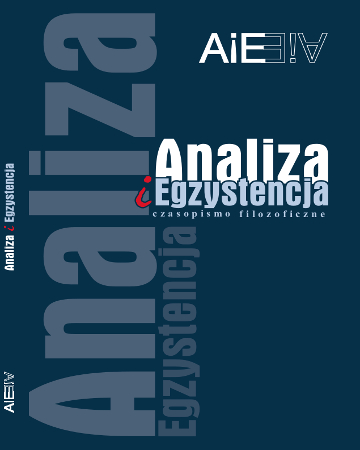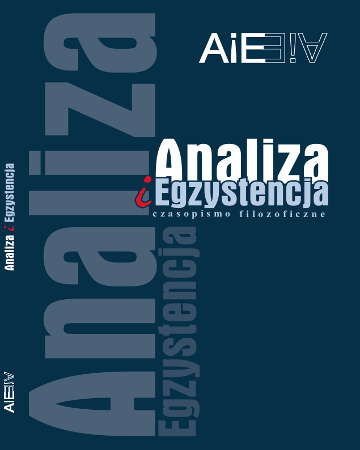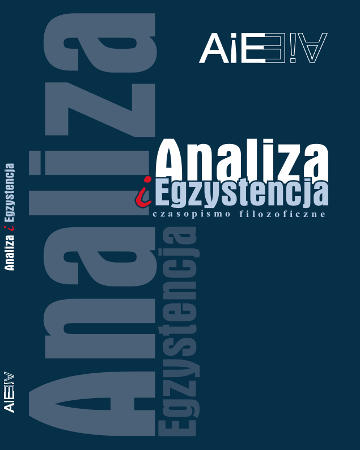
We kindly inform you that, as long as the subject affiliation of our 300.000+ articles is in progress, you might get unsufficient or no results on your third level or second level search. In this case, please broaden your search criteria.


The article propounds an interpretation of Nietzsche’s philosophy, in which the issue of illness would be instrumental. However, in contrast to any kind of reductionary biographism, the illness should be conceived as inextricably intertwined with the thinking itself. Nietzsche’s own illness was initially nothing more than a personal problem, yet it soon influenced his whole life, forcing to forgo the academic career. Thus afflicted, the philosopher used his experience to develop a new view on corporeality, diametrically opposed to Cartesianism. In the post-Cartesian model, objective thinking and illness have nothing in common; either corporal suffering exerts no influence upon thoughts, or the mind sinks into pure insanity. Whoever lost their faculties is still capable to stick to rationality, if only they accept the diagnosis, however subjectively unconvincing it would seem. Suspicious of the notion of truth, Nietzsche reverses the post-Cartesian model. Objective thinking, neatly separated from illness, as well as rational diagnoses appear to him as a fetish supporting those who cannot deal with their own corporeality. They repress their weaknesses, assuming the unfounded belief in objective thinking, which can be practised irrespective of personal malaise. However, Nietzsche’s suffering, which recurred irregularly and had no detectable grounds, couldn’t be separated not only from thinking, but from life as such. The philosopher was thus lead to advance a concept of “diet”, construed as broadly as possible, including the selection of food, lectures and embraced thoughts. The diet is the uttermost refutation of diagnosis, as it treats the mind and the body as a unity changing in time. The illness, which accompanies life inevitably, serves as a permanent yardstick of quality of our thoughts. Moreover, it gives us the opportunity to experience pure becoming.
More...
The aim of the present article is to reveal the essential connection of MichelFoucault’s critical attitude regarding social relationships with the formation of thepostmodern ethos of making out of the human life an artwork. It will be shown thatthe main object of Foucault’s critique are the relations of power and knowledge inthe Christian priesthood and their modern transformation in nonreligious institutions.From this point of view, mainly based on the philosophy of Friedrich Nietzsche,the Christian ethics occur to be an accumulation of techniques of disciplinizationand normalization. This attitude towards Christianity and modernity leads to thepostmodern ethos of making out of life an artwork. This notion is mainly based onthe antique Greek and Roman philosophy, where instead of obeying to universalethical principles the human being struggled to be his own master. Therefore thepostmodern existence tries to be beyond all traditional boundaries, which resultsin the danger of neglecting the historical fact, that Christianity was and still is animportant institution of the Western Civilization
More...
This scientific article treats of libertarianism. Its fundamental premises are: conceptionof self-ownership, non-aggression axiom, proprietorship, free market, ‘no victim, no crime’ rule, aversion to the state institutions. The existence of libertarianism itselfis the most prominent subject of dispute between its two currents: minarchism andanarcho-capitalism. The adherents of the doctrine of minimal statism were FriedrichA. von Hayek and Milton Friedman, while Murray N. Rothbard and Hans-Hermann Hoppe were the followers of the free-market anarchy. The traditional, one-dimensional division into the left and right wing is not sufficient for the libertarianism to find its place on the political scene. It is multidimensionality that characterises the libertarian thought.
More...
As a literary work, Jean Paul Sartre’s theatrical arts gathered together in a Polishpublication named Dramas propagates and illustrates in detail the real philosophicalmasterpiece which is Being and Nothingness. Inspired by the author’s philosophicaldoctrine, dramas were made to show the existential thought. In that way Sartre-philosopher in Being and Nothingness reveals his thought in a explicative way. On theother hand, Sartre-playwright by writing dramas creates unrestricted realities whichcan be in various ways projected into the readers’ imagination, and there his generaltheses find detailed application. Philosopher wanted to show the philosophical truththrough literature, and he was very consistent about it. Being and Nothingness andDramas could be treated as sources of knowledge about his philosophy, just like hisnovels or works about his literature. Sartre uses his philosophical program to realizehis ideas for prose. It appears that philosopher did not divide the notion between“philosophical literature” and “literary philosophy”.Sartre is the creator of the theater of situations because characters from hisdramas find themselves in concrete situations and they have to make specific decisions.The dramas of the philosopher have a moralistic tone because we see inthem Sartre’s concept which says that humans may reject the role which societygave him. Man can choose the authentic existence. Philosopher’s mission was toinfluence the readers of his works. He desired to convey to people the truth abouthuman freedom. In conclusion, Sartre’s dramas are a kind of theatrical phenomenon,because as a philosopher he interested the spectator as much as an playwright.
More...
Theory of art as so called the theory of intuition-expression extremely and clearlydemonstrates the way of a mystic experience as a experience of the Absolute. Croce’sconcept of the Absolute is a sign of being spiritual, no diverse in itself, what is morefully given in an emotional (feeling) artistic expression (artwork). Imagination asan appropriate representational power expressively became, in this context, the sphere of the Absolute (indifferent intuition, totality of Being) in which the Absolute realizes – through creation of art – the material world. An artist, because of his creative imagination, appears for Croce as a complete, perfect man and fulfills a creative and demiurge function for the world. According to Kandinsky, inspired by Steiner’s antroposophy, art doesn’t present concrete things but using a maximum simplistic concrete form, expresses and shows things in itself, as an ideal, spiritual, absolute but compared to the world of concretes, the mentioned things are internal, substantial, essential and “abstractive”. Abstraction as a “true reality” demands of giving up the empirical world and looking continuously at the sphere of absolute “necessity”. Art is a specific, inspired knowledge of the Absolute and an abstractartist inspired by this knowledge and expressing it in his artworks must be understoodin a way characteristic of mysticism (an inspired visionary-prophet, perfect man).In Adorno’s aesthetic theory art actualizes the nature in aspect of beauty and thisactualization consists in changing towards the lack of identity. An individual (eachone ) artwork is the “epiphany” of “spirit” of art, that is an aesthetically Absolute.As a result an artwork presents itself as a kind of “mystic event”, but an artist expressingthe sphere of the Absolute still be an inspired visionary going beyond the natural (empirical) order.All of these theories of art are based on the old neoplato-arabian theory of “creativeimagination” which determinates their quasi- or pseudo-mystic aspiration. They are not go beyond tradition, that is “natural mysticism” (characteristic of pantheism).This kind of mysticism differs from revelation mysticism on the grounds of Transcendence (aspect of a object) and classical moment of contemplatio (aspectof a subject).
More...

Sidgwick’s defence of esoteric morality has been heavily criticized, for example in Bernard Williams’s condemnation of it as a ‘Government House utilitarianism’. It is also at odds with the idea of morality defended by Kant, Rawls, Bernard Gert, Brad Hooker, and T.M. Scanlon. Yet it does seem to be an implication of consequentialism that it is sometimes right to do in secret what it would not be right to do openly, or to advocate publicly. We defend Sidgwick on this issue, and show that accepting the possibility of esoteric morality makes it possible to explain why we should accept consequentialism, even while we may feel disapproval towards some of its implications.
More...
In the article I claim that the problem of abortion cannot be solved by referring tosuch biological fact, as having human genetic code by any prenatal being.
More...
The article is a reductio ad absurdum of assumptions which are shared by a largenumber of followers of the animal welfare movement and utilitarianism. I arguethat even if we accept the main ethical arguments for a negative moral assessmentof eating meat we should not promote vegetarianism but rather beefism (eating onlymeat from beef cattle). I also argue that some forms of vegetarianism, i.e. ichtivegetarianism,can be much more morally worse than normal meat diet. In order to justifythese thesis I show that there are significant moral differences in the consumptionof animal products from different species.
More...



The paper is devoted to the problem of the two paradoxes: the paradox of absolutevalue in Wittgenstein’s Lecture on Ethics and the paradox of Anselm’s Name of Godfrom the Proslogion. I try to present semantic determinants of the paradoxes as wellas similarities of their structures. However, the main part of the article focuses on thesolution of Anselm’s paradox given by Cora Diamond, the prominent Wittgensteinianscholar in her paper Riddles and Anselm’s Riddle. Diamond develops extensivecomparison of the concept of that than which nothing greater can be conceived anda series of peculiar riddles – she calls the Anselm’s concept the great riddle, since, asin other riddles presented, we cannot deal with it in a usual way. The author showsthat what enables us to resolve, say, the riddle of Sphinx, is our obtaining a new wayof understanding the words which compose the riddle itself, for the old way will notlead us to the proper answer. However, when it comes to the great riddle we knowthat we cannot obtain any way of understanding which will enable us to conceiveit. This does not mean that the riddle cannot make any sense for us. We can believethat there is a solution (in fact, we have the solution – it has been given to us inthe Revelation – but we cannot understand it) so we can treat the great riddle as aneuqation which we lack proof but we know there is one. As Diamond calls it, wehave the promissory meaning of the riddle. In my opinion the idea of the promissorymeaning is an interesting solution of Anselm’s paradox, but I notice that the ideaitself is conditioned by religious faith or by something I call the empathic atheism(in short: an attitude which lets atheists take the believers’ point of view).
More...
In the article Popper, Tarski and Relativism Jennings argues that according to T-equivalence all ontology (all sort of things in the world) is the derived from the first-order language. So such argumentation leads directly to the relativistic interpretation of Tarski’s semantic theory of truth. This interpretation is very controversial especially given that almost all philosophers of the Lvov-Warsaw School assert that truth is a nonrelativistic value. It seems that Alfred Tarski shares this view with Kazimierz Twardowski and his students. However there are many incompatible interpretations according to which the semantic theory of truth generates different consequences. Thus we can understand this theory in a relativistic, deflationist or absolutist ways. In this article I am reconstructing the relativistic and nonrelativistic interpretations of the semantic theory of truth and I attempt to provide an answer to the important question about whether or not Alfred Tarski is a relativist?
More...
The main goal of this article is to outline Barry Stroud’s conception of philosophy.Philosophy, in his opinion, aims at understanding of various kinds of phenomenaand our attitude towards them, but this understanding doesn’t manifest in a set ofphilosophical theses. A philosopher should become aware of a peculiar character ofunderstanding which he wants to reach, and in consequence, admit that a metaphilosophicalreflection is integral part of philosophical investigations. An understandingof the nature of philosophical investigations is not possible without pointing to theirsources. Thus the task of a philosopher is to diagnose philosophical problems byshowing from which earlier questions and theories they have arisen. On the otherhand, philosophical reflection must be always confronted with the things which areaccepted by all of us, otherwise understanding caused by that reflection wouldn’trefer to phenomena belonging to our world. Stroud thinks that a description of one’sconception of philosophy requires looking at the manner in which that philosopherapproaches to a given problem. Acknowledging the rightness of his remark I considerhis approach to philosophy using as an example his treatment of the question “whatis meaning?”. I point out that Stroud looks into the source of the Wittgensteinian slogan “meaning of the expression is its use”. The main Stroud’s conclusion is thatif a description of a use of a certain expression is to explain the meaning of thatexpression, semantical terms have to appear in that description. This statementcould be abandoned, Stroud claims, only if we rejected the things which all of usacknowledge as obvious.
More...
In the article I am describing epistemology R.H. Lotze’s, which as first enteredcomprehending the value into language of philosophy. He emphasized the limitationof the human mind in his project. He thought that metaphysics was insufficient asa base for science to arise. Therefore the sphere of the human cognition is supposedto be limited to a system of the importance and its confirmation in experience.As a result of such a thinking, it is necessary to express the cognition through thevalidity. Namely through the awareness of stretching it what detailed and general.
More...
In the paper Charles Taylor’s notion of strong evaluation and its crucial role inrelation to human agency has been presented. The departure point of our analysisis Harry Frankurt’s famous distinction between first- and second-order desires.Then, following Taylor, we describe two separate ways of evaluation of our desires– weak and strong evaluation. In further discussion the reconstruction of Taylor’stranscendental claim concerning the inescapability of strong evaluation in relationto selfhood is given. Finally we consider criticism that Owen Flanagan poses aboutTaylor’s account.
More...
The aim of the article is to describe the theoretical basis of the liberal democracyaccording to Ernest Laclau. His conception is a useful device for the analysis ofa socio-political situation of Others (the Excluded). By exposing Laclau theoreticalperspective (discourse, empty signifier, hegemony, emancipation) I attempted todisplay that this perspective does not only define the significant frames, thanks towhich the social life may go further, but it also reveals the multiplicity of contexts,diversity of social issues and various possibilities of their interpretation. Importantfactor of this perspective is that it points out the need for taking the action, which isaimed to improve democracy. According to Laclau the moment of visualization ofour desires is much more important than its realization, because it drives us towardaction and creative thinking.
More...